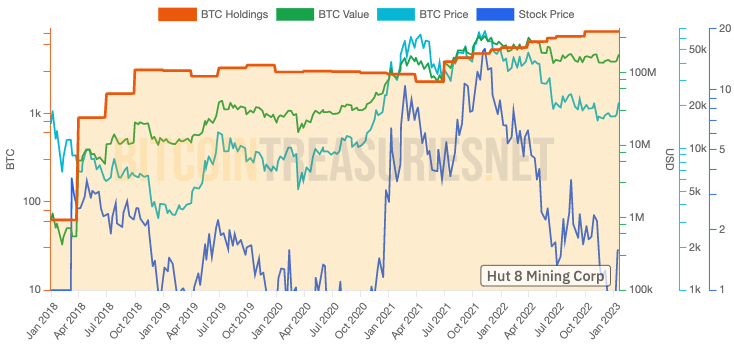
Crypto miner explains how Bitcoin mining stabilizes grids

Hut 8 CEO, Jaime Leverton explains how Bitcoin mining can stabilize grids, create jobs and generate tax revenues in an exclusive Davos interview.
2022 was “the perfect storm” for Bitcoin (BTC) miners, according to Jaime Leverton, CEO of Hut8 mining, one of the largest crypto miners and digital asset experts in the space.
Leverton sat down with Gareth Jenkinson, senior reporter at Cointelegraph, in an interview at the World Economic Forum in Davos, Switzerland. Topics included were the 2022 bear market, Web3 diversification and, crucially, Bitcoin’s growing positive impact on the environment and broader economy. Leverton shared that 2022 was a turbulent year for miners:
“Obviously depressed Bitcoin prices, global hashrate continues to hit all-time highs and then an energy crisis is thrown in the mix. So it’s certainly been a challenging time within the mining industry in particular.”
Bitcoin hash rate, the ease at which miners can find a new block on the Bitcoin time chain and receive the block reward, has climbed higher in recent months. That’s despite the Bitcoin price bobbing below $20,000. Mining profitability plunged as the hash difficulty surged. As a result, there were several Bitcoin and crypto miner casualties throughout 2022.

Leverton explained that a diversified strategy coupled with a successful M&A plan helped stave off insolvency risks for Hut 8, one of the world’s largest publicly traded Bitcoin and crypto mining companies.
The group recently spun up a “Bitcoin and mining repair facility for customers in across Canada and Northern Europe.” Meanwhile, a merger led to the purchase of “five enterprise-grade data centers and the associated business.” Leverton highlighted that this move attempts to fill a gap in the market for digital infrastructure providers in the Web3 space:
“They tend to be really dependent on the traditional Web two hyperscalers as they, as they try to build out these decentralized platforms. And obviously, when you’re building a decentralized network, you don’t want to do that in, in centralized infrastructure.”
Web3, once a buzzword in the crypto space, has since become a hotly-tipped trend for 2023, attracting 10-figure-plus investments from Hong Kong to Abu Dhabi. The entrance of Hut 8 into Web3 could usher more Bitcoin-only companies to consider opportunities in the Web3 space.

The interview concluded with an astute discussion of Bitcoin mining and its role in protecting the environment. Leverton is a founding member of the Bitcoin Mining Council, a group engaged in dispelling the misinformation surrounding Bitcoin mining and “tackle some of the misinformation that was coming out around Bitcoin’s energy use; the sources of energy.”
Leverton explained that Bitcoin’s transparency could in fact be its Achilles heel:
“Part of the challenge we have is Bitcoin’s energy use is so transparent. Unlike every other industry in the world, where their energy consumption is opaque. With respect to Bitcoin mining, you can see the energy produced because, essentially Bitcoin is digitized”
In contrast, it is a Sisyphean task to quantify the entire energy output of banking or traditional finance, although it hasn’t stopped some Bitcoin advocates from trying. In a recent interview with cryptographer Michel Khazzaka, he estimates that Bitcoin uses at least 56 times less energy than banking.
Related: Seven times Bitcoin miners made the world a better place
Leverton explains that there could be a disconnect between Bitcoin mining and its positive impact on both the environment and the economy. “It starts with education,” she explained. A native Canadian, Leverton tees up an example of how Bitcoin mining creates jobs, stimulates the economy and even provides tax receipts in a small city in Alberta Province.
“We’re their largest energy customer, their largest taxpayer, and a key provider of tech, labor, and in some cases, we also want to talk about joint curtailment with the city of Medicine Hat.”
Furthermore, Bitcoin mining can help to stabilize grids. Texas recently tinkered with the idea of using software to further balance the supply and demand of electricity to its grid using Bitcoin miners. Similar to Texas, Canada also endures temperature extremes. The wild variations require expert grid balancing.

Leverton explains how Bitcoin mining can support the grid in Medicine Hat, further example of Bitcoin mining’s role in supporting environmental efficiency:
“And in whatever increment, we can take the entire 62 megawatts down and feed the grid if it’s during a snowstorm, any type of peak demand activity, we can power down and feed the entire amount or as little as half a megawatt.”
Crucially, conversations and educational drives among policymakers might be made easier given that Bitcoin miners are now the largest taxpayers in the region where Hut 8 operates.
Go to Source
Author: Joseph Hall









